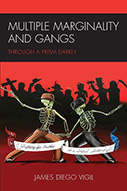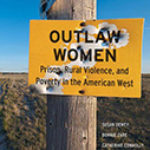Multiple Marginality and Gangs: Through a Prism Darkly

Author: James Diego Vigil
Publisher: Lexington Books. 2020. 140 pages
Reviewer: Timothy R. Lauger ǀ November 2021
In Multiple Marginality and Gangs: Through a Prison Darkly, James Diego Vigil continues to develop the multiple marginality framework he first introduced in the mid 1980’s. Vigil draws on over 40 years of research in Los Angeles to argue that street gangs arise when groups of people are marginalized or pushed to the fringes of society, and experience social and economic conditions that destabilize their lives. The multiple marginality framework identifies how ethnic minority communities suffer from persistent and intense strains across macro, meso, and micro dimensions of social life. Adolescents living in a marginalized community suffer from diminished status and experience challenges or problems that accompany social, cultural, and psychological dynamics crucial for development. Marginalization specifically influences individual’s “connections, engagements, involvements, and beliefs,” or what Vigil calls the four dimensions of social control (p. 11). Adolescents diverge from “the path of conformity” when traditional forms of social control break down and become exposed to street socialization and street subculture, which advocates unconventional, at times delinquent, behavior. This happens at a time of development when teenagers are uncertain about their social identities and look to both influential peers and older role models for guidance. The gang fills voids left by deficiencies in traditional social control systems, like parents, schools, and law enforcement, and provides a sense of belonging or identity to marginalized youth.
Marginalization for ethnic minority communities in Los Angeles is linked to historical immigration patterns in which laborers moving into the area obtained low paying jobs and were housed in low rent communities with poor infrastructure and living conditions. Immigrants desire to live among people like themselves, coupled with racist attitudes from outsiders to “keep them separate because they look different’ (p.20) created segregated communities isolated from vital social, cultural, economic resources needed to achieve upward mobility. Such challenges remain today, as residents in marginalized communities continue to have limited access to both well-paying jobs and adequate education so that the “ladder for social mobility is either broken or the first rung is placed very high” (p. 26). As economic pressure mounts and living conditions become or remain crowded, families experience increased strain, which reduces caregiver’s ability to monitor children who then spend more of their time on the streets. Once on the streets, youth are subject to street socialization and may begin to refer to themselves as “cholo,” which roughly translates to marginal. Their status in society becomes a stylized public presentation.
Vigil specifically focuses on how marginalization leads to the breakdown of three traditional forms of social control: family, education, and law enforcement. Families residing in poverty areas experience multiple challenges like chronic unemployment, inadequate employment skills, neglected housing, and reduced government assistance while also being exposed to gangs and drugs. This leads to an array of adaptive behaviors. Some residents respond to cutbacks in social programs and support networks by participating in the underground (sometimes illicit) economy, which undermines their ability to maintain stability within the family or on the streets. Female single-parent households are especially challenged, as they exhibit lower income levels and less ability to monitor children. Additive strains on families produce the motivation and opportunity for youth to affiliate with gangs, and parents of gang members report strains more often than parents of non-gang members. Many parents of gang members, for example, are more likely than parents of non-gang members to describe their own childhood as miserable, abusive, and full of conflict. They lack the social capital or social support system as parents to properly regulate children’s behavior outside of the home, and their children are more likely to be exposed to street socialization.
The effects of marginalization extend to and become intensified in the educational system. Positive social control aspects of schools for most marginalized minority populations are all but absent, and students experience a conflict between minority and majority cultures that interferes with learning. Street children, or those who have strained home lives and spend more time on the street than at home, come to school not only with emotional baggage, which negatively affects learning and classroom behavior, but with an anti-authority attitude learned on the streets that undermines school performance. School could help solve some of the deficiencies of home life, but it is a stark contrast to the streets and is accompanied by unattractive expectations for street kids. Schools, in turn, often fail to adequately respond to challenging students by embracing reactionary policies that exacerbate problems. For example, teachers and administrators may keep street kids away from the rest of students by grouping them together to create an extension of the streets inside the school. Failure in school further decimates the already fragile egos and low self-esteem of street kids, so that participation in a street group or gang becomes even more attractive. The broken egos of street youth join together to create a unified group identity aligned with a status and reward system contrary to that of the educational system. In turn, schools intensify their reactionary policies by punishing and/or expelling the most troublesome students, causing gang youth to either focus fully on street life or attend alternative schools that function as warehouses or “soft jails.” Vigil argues that schools must rethink their approach to street kids by balancing prevention, intervention, and suppression goals rather than just relying on aggressive gang suppression policies.
When families and schools are unable to exert social control over youth, the street may become a primary source of socialization, and “police become the last bastion of social control” (p. 55). Police have strained relationships with marginalized communities and gang members view themselves as resisting an oppressive force that attacks their community. This tension, which has a long history, has persisted because of moral panics about gangs and police departments’ tendencies to both exaggerate the scope of the gang problem and pathologize gang members so that only police can deal with them. Gang members do engage in criminal behavior such as violence, drug use, and property crime, which Vigil describes and explains. Police are, therefore, forced to deal with problems they did not create, but they too often instigate interactions with the gang in a way that intensifies hostility. Gang members often claim they are unfairly targeted by the police for relatively mundane activities like partying. The tension between police and gangs persists, as over and under enforcement of the law can create animosity in already strained communities.
The breakdown of vital social control mechanisms in homes, schools, and the legal system impact marginalized youth at an important developmental period of life. Teens experience both the hormonal changes of puberty, and a process of psychosocial moratorium in which they struggle with identity and look to peers and slightly older role models for guidance. During this time of confusion and identity development, youth find certainty and security within a group’s identity or what Vigil calls the group’s “ego ideal.” Eventually, participation in group life can cause personal identities of gang members to become saturated by the ideals of the group. Gang members may become social chameleons by publicly performing their gang role in select situations. Acting tough is one way to perform the gang role, but commitment to this role varies across gang members. Some members are genuinely tough while others merely perform like they are tough with varying degrees of persuasiveness. Gang members also embrace being loco (crazy), which is a state of mind that is fearless, tough, dangerous, and unpredictable. Being loco is a requisite for street survival and to be emulated, but it is more likely to be embraced by gang members who have experienced a difficult early life, encountered street socialization at a young age, and are more fully integrated into the gang’s core. The cascading effects of marginalization, strain, and breakdown of social control systems are experienced more intensely by some gang members who then adapt by more fully embracing gang ideals, like being loco.
Vigil’s multiple marginality framework examines how marginalization impacts communities, groups, families, and individuals in ways that contribute to the proliferation of street gangs. With his framework developed, Vigil acknowledges that new developments in society will influence how marginalization impacts communities and, by extension, gangs. Immigration patterns and policies continue to change along with the racial and ethnic composition of the United States. In an increasingly global society, gangs have become transnational, as gangs such as MS-13 have emerged and become the focus of law enforcement attention. Hysteria about gangs and minority populations shift, influencing the nature and extent of marginalization. Crime policies also change over time and have different effects on communities, gangs, and gang-related behavior. Given these changes, scholars should continue to examine the role of marginalization on communities, and utilize Vigil’s multiple marginality framework to better understand the impact of these changes on street gangs.
Timothy R. Lauger is an Associate Professor of Criminal Justice at Niagara University


